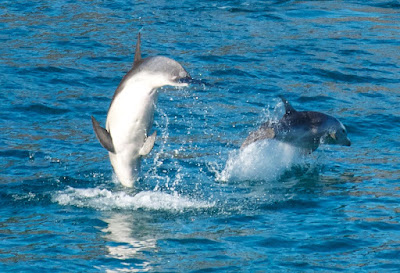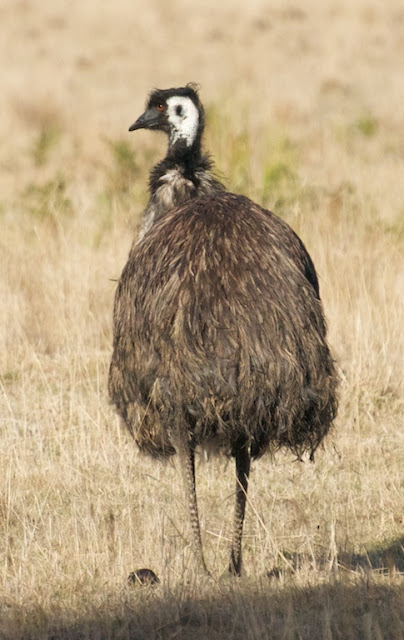I had carefully planned our Tasmanian trip to put us in Hobart on Saturday (March 22, 2014) so that Eileen, who loves open-air markets, could visit the city's famous Salamanca Market. For our second week in Tasmania, we were to leave Hobart behind and drive north, past the beautiful scenery of the east coast, on the first leg of a circuit of the island.
A puddle in the dirt road leading into the reserve attracted a Brush Bronzewing (Phaps elegans), a pigeon that prefers dense undergrowth (and is therefore, at least in my experience, hard to see - this was my first really good look at one).
The next day, we left Hobart for the northeast. We made a brief stop at the Tasmanian Bushland Garden, a reserve devoted to native plants that is entirely staffed and run by volunteers. Had I known of its existence beforehand I would have planned a longer visit - it seemed well worth it, and entry is free.
We reached the coast at a very attractive lookout, opposite Maria Island (reportedly a fine nature reserve in itself, and another place I would like to have visited on its own).
Barring a trip to the island, a stroll along the beach was a nice way to enjoy the area...
...especiallly considering that the beach displayed a pretty good collection of shells. The large, sand-filled valve at the top appears to have come from a Cloud File-Shell (Lima nimbifer).
As we continued north, we began to get an idea of the toll cars take on local wildlife. Tasmanian Padamelons (Thylogale billardierii) were commoner dead than alive on the roadside. According to a site devoted to reducing wildlife deaths, 293,000 animals, including almost 29,000 padamelons, die on Tasmanian roads each year.
Probably the most magnificent spot on the northeast coast is the Freycinet Peninsula, much of protected in a national park. A visit here can be a drawn-out affair; much of it is only open to hikers. Access by car is limited to the northern end of the park, and to the small community of Coles Bay where we stopped to explore a collection of rocks and tidepools jutting out from the Esplanade, the coastal road that circles the town.
Fissures in the rock were stuffed with algae and encrusted with rock barnacles.
The beaded strands of Neptune's Necklace (Hormosira banksii) made it the most easily-identifiable of the local algae.
A lone biscuit star (Tosia sp.) sits in a shallow rock pool. These sea stars are highly variable in colour; this is a comparatively dull one.
From Coles Bay we drove on into the park itself. Our time was limited, so we decided to visit the one lookout you can reach by car, along the Cape Tourville Road to the east. On our way, my first-ever Wombat - an animal we would see and photograph to much better effect later in the trip - scuttled across the road in front of us.
The walk to the lookout at the end of the road is both short and spectacular.
To the south, the coastal scenery is magnificent; out to sea, the Nuggets hold breeding colonies of a number of (unseen) seabirds.
About two-thirds of the way back from the lookout trail, at a point where the Cape Tourville Road takes a sharp bend, another trail leads to a lookout over an aquamarine bay. Ryan isn't pointing at the scenery - there is definitely something moving in the middle of the bay...
...a pod of bottlenose dolphins, leaping and sporting in the waters. Before getting too excited about this, though, let's spend a moment deciding what to call them. If you look at the file names I have given these photos, you will see that I have called them Indo-Pacific Bottlenose Dolphins (Tursiops aduncus). My bad; that species does not seem to occur south of Queensland. However, deciding what species the bottlnose dolphins of Tasmania belong to has its own problems. They have been called Common Bottlenose Dolphins (T. truncatus), or a separate Australian species (T. maugeanus) now not usually recognized for a variety of technical reasons.
In 2011, though, a new analysis by Kate Charlton-Robb and her colleagues, based mostly on molecular data, recognized the coastal dolphins of Victoria, Tasmania and South Australia as a species in their own right, the Burrunan Dolphin (T. australis) [Burrunan is an Aboriginal word for a dolphin-like animal]. These are surely Burrunans; one identifying mark is that the pale colour of the underside reaches above the eye, a feature easy to see in this leaping animal.
I was delighted to see that our dolphin group included a mother and baby, frolicking together.
The Burrunan Dolphin is a species already under threat, broken up into tiny, disparate populations, with less than 100 animals estimated per local region. Its genetic diversity is low compared to other dolphins, and each subpopulation is probably inbred. Surely a baby, like this one, is nonetheless a good sign.
From Freycinet National Park we turned again to the north, away from the coast for a while. Here are two creatures we found on the way, on quite differing size scales: first, a Marbled Xenica (Geitoneura klugii), a member of a uniquely Australian genus of butterflies...
...and secondly, an Emu (Dromaius novaehollandiae). Emus are native to Tasmania - or rather were, before the smaller, darker native subspecies was hunted to extinction in the 19th century. Mainland birds were introduced but they, too, were shot out. In the 1990s emu farming came to Tasmania in a big way; this is surely a bird from a farm.
Our goal for the night was Bicheno, and a nightime penguin walk, complete with extremely close views not only of Litle Penguins (Eudyptula minor) but of Southern Brown Bandicoots (Isoodon obesulus). Unfortunately, photography was forbidden - so you'll have to take my word for it that Ryan and I had a good time!


































No comments:
Post a Comment